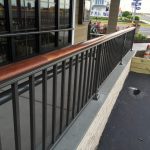
Making an Informed Choice
Would you agree that we live in a litigious society? Without any consideration to the merits of any particular “lawsuit”, would you not agree that the possibilities of being sued are ever present? This is true individually but more so if you manage a business or have some responsibility in choosing what products are used.
Whether building a new structure or upgrading an existing one, Building Codes have been created for the purpose of protecting occupants and users of the structure. When an incident occurs, one of the first things considered is the applicable Building Code(s) to determine if any violations exist, which may have contributed to the incident. Is just meeting a particular code enough? It is a devastating fact that often, the goal is not to improve safety, but to find basis for litigation.
There are several authorities that have contributed to creating a National Building Code. This is a positive development. Architects, Contractors and Manufacturers must be familiar with the codes in each market where they operate, design or sell their products. Many manufacturers have spent hundreds of thousands of dollars with certified testing facilities to show their products meet and / or surpass code requirements. Many require a safety factor several times code. While this article is not a technical guide on building codes or couldn’t possibly address every product that could be used, it is intended to promote questions that could apply to most products. Simply put – is claiming to be “Code Compliant” enough? We will focus on one building product that is often overlooked, however this could apply to almost any product or material.
When your safety is concerned, or that of your occupants, the astute specifier or owner will not skimp on research. One of the most liability-prone products is the railing used on the ramps, walkways, porches, balconies, roof top perimeters, boardwalks, and stairs. Railing is so familiar and commonly needed, it is often given little attention. Unfortunately, this approach may mean missing the technological advances and updated products available in the railing industry. More attention needs to be focused on the factors needed to insure that a railing system will continue to meet the design code or strength once installed.
- Will the system retain sufficient margins of safety once the influence of use, abuse, the environment and weather take their toll? Keep in mind that testing is done in a controlled environment.
- How do you insure that proper installation and fastening will maintain the same safety margins?
There are various types of materials used to manufacture railing. Depending on the intended use, railing is made from wood, steel, aluminum, plastics, glass, etc. and a variation or combination of these. Not all are appropriate for every type of structure. With the internet, there is a wealth of easily available information on the pros and cons of each. Speaking to your local distributor or manufacturer can help, but may not be sufficient.
Things to consider:
- Does your source handle or make just one or two types of railing?
- Will they attempt to steer you to their own, even when a system more appropriate may be available?
- Not all rail is created equal. As with most products, there is often a good, better, or best grade in each category. Is your source knowledgeably concerning the benefits of various paints, power coatings, metals, plastics, gauges and qualities of both metals and thermoplastics? What experience do they have with each?
Knowing the answers are incumbent on making the most appropriate decisions.
Let’s look at some questions which should be asked. Many are common to each. For example, most railing systems are made in a residential and commercial grade. Quality is always important and must be balanced between need, value and cost. You would not want to use a residential strength system on a high rise or multi-story building or a heavily used area subject to large crowds or abuse. Beyond certified testing showing code compliance, here are some important questions to ask;
- Aluminum. What gauge? Welded or mechanical? Painted or Powder Coated? What pre-treatment is used to insure adhesion of the finish? Can this material withstand the effects of a coastal salt laden environment? Is the system a boxed program, designed to be field trimmed and fabricated, or is it made to fit my building? What danger is there that if not properly field assembled, the system will maintain its strength and therefore, code compliance?
- Thermoplastics. Plastics are “recipes” or formulas. What type of plastic? Is it PVC, ASA, HDPE? Can I use the same PVC residential deck railing on a commercial structure? Is the railing reinforced for strength? Do the issues common to some plastics, that of fading, brittleness, lack of colors, etc., apply to all type of plastics? Why would one use a “plastic” system in a highly corrosive of abusive application?
- Steel. What grade and gauge of steel? What about the finish and potential for rust? Is the system welded or mechanical?
The aforementioned are but a few of the generic/basic questions. Each project will have its own idiosyncrasies. Also important to know; is the manufacturer confident enough in his product to offer a warranty? As with all warranties, the devil is in the details, so be sure to read the fine print.
Of course, having a uniform building code is important and beneficial. While knowing the details is not guaranteed against potential lawsuits, it can mitigate the risk. For this reason and your own satisfaction, it is necessary to consider these factors before, during, and even after a product is chosen and installed.


